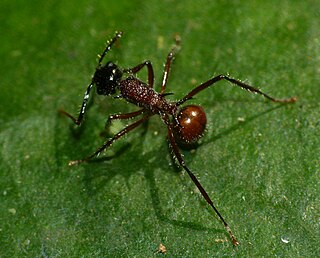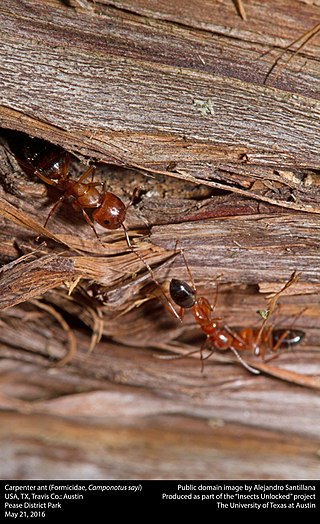
The Hydroscaphidae are a small family of water beetles known commonly as skiff beetles. As of 2010, there are 23 species in the family. Several are recently described.
Polyrhachis sokolova is a species of ant from Australia and New Guinea that recently was discovered to be capable of surviving tidal inundations.

Pogonomyrmex colei is a species of workerless inquiline ant in the subfamily Myrmicinae native to California, Nevada, and Arizona that parasitizes Pogonomyrmex rugosus nests.

Tetramorium caespitum, also known as the red pavement ant, is a species of Myrmicine ant native to Europe, Morocco, and western Asia, but now found on many other continents as a tramp species.

Dulichius inflatus is an ant mimic bug in the family Alydidae that is found mainly in southern India and Sri Lanka. It is said to live in the nests of ants Polyrhachis lacteipennis which it morphologically resembles.

Polyrhachis is a genus of formicine ants found in the Old World with over 600 species. The genus is yet to be comprehensively resolved and contains many varied species including nest-weavers, swimming workers, soil and tree-dwellers. The first fossil record of this genus was of Polyrhachis annosa from the Miocene.
Physogastrism or physogastry is a characteristic of certain arthropods, where the abdomen is greatly enlarged and membranous. The most common examples are the "queens" of certain species of eusocial insects such as termites, bees and ants, in which the abdomen swells in order to hold enlarged ovaries, thus increasing fecundity. This means that the queen has the ability to hold more and produce more eggs at one time. Physogastric queens produce an enormous number of eggs which can account for a significant amount of their body weight. In the termite species Macrotermes subhyalinus, eggs can make up a third of their body weight, and a 15-gram queen can produce up to 30 eggs per minute. The physogastric queens' egg production is supported by oocyte proteins supplied by the "queen body fat."

Camponotus japonicus, commonly known as the Japanese carpenter ant, is a species of ant native to eastern Asia. It is black, and one of the largest ants. A nest has about ten to thousands of individuals, and it can be a pest when it enters households or protects aphids. There are several subspecies of this ant in different areas of Asia, with the largest of the species being located in northern China.
Polyrhachis punctillata is a species of ant in the subfamily Formicinae, found in few Asian countries. Three subspecies are recognized.

Grylloidea is the superfamily of insects, in the order Orthoptera, known as crickets. It includes the "true crickets", scaly crickets, wood crickets and many other subfamilies, now placed in six extant families; some genera are only known from fossils.

Tyrannomyrmex rex is a species of ant in the subfamily Myrmicinae native to Malaysia and Singapore.

Aphaenogaster uinta is a species of myrmicine ant native to the western United States and possibly Saskatchewan.

Pogonomyrmex bicolor, the bicolored harvester ant, is a species of harvester ant native to Arizona, Sonora, Chihuahua, and Sinaloa.

Camponotus sayi is a species of carpenter ant native to the southwest United States, northern Mexico, and possibly North Dakota, Ontario, Mississippi, North Carolina, South Carolina, and Florida.
Abscondita chinensis, is a species of firefly beetle found in India, China and Sri Lanka.

Polyrhachis mucronata is a species of ant in the subfamily Formicinae native to Oceania and Southeast Asia.

Stictoponera is a genus of ants in the subfamily Ectatomminae. They are found in Southeast Asia and Oceania. The genus was synonymized under Gnamptogenys for a long time, however Camacho et al. 2022 reinstated the validity of this genus.

Polyrhachis follicula is an ant in the genus Polyrhachis native to the Philippines.















